Load Charts: What You Need to Know about Reading Them
- Carmen Zajicek

- Aug 6, 2020
- 2 min read
One of the most important safety resources a crane operator must know is how to read and understand their crane’s load chart. The load chart informs the operator about the crane’s lifting capacity.

According to a study, overloading is one of the leading causes of crane accidents. Each crane type, model, and make will have a different load chart, so it’s vital that both managers and operators meticulously study each crane’s load chart in order to ensure accidents don’t occur.
Ignoring the differences between disparate load charts can lead to structural failure or even crane overturning.
We’ve prepared this guide to help you understand what’s involved in reading a crane load chart.
Understanding Load Charts
There are several terms and numbers listed in a crane’s load chart, including the rated/gross capacity, boom lengths, operating radius, loaded boom angle, jib deductions, and more. Here’s a guide:
Gross Capacity and Net Capacity
The rate or gross capacity listed on a crane’s load chart isn’t the actual load that can be attached to and lifted by the hook. That load is called the net capacity. You must ensure that the maximum load never exceeds the crane’s net capacity.
The crane’s gross capacity includes the weight of all parts and accessories stowed or mounted on the crane’s boom or hanging off the tip of the boom. These are known as capacity deductions. They include:

Main load block weight
Overhaul ball or headache ball weight
Jib weight (Stowed or erected and not used)
Weight of all hanging cables
Weight of all rigging equipment
Load weight
Counterweights
Counterweights are critical to understanding the amount of weight a crane will be able to handle. As the name suggests, counterweights work to balance the applied load to the crane when it lifts an object.
Jib Capacities
Selecting a 24 ft or 40 ft jib, as well as the boom angle, allows you to determine the gross capacity of the jib. The main purpose of a jib, boom extension, or fly is to increase the overall height for lifting a load.
In addition to knowing how to read a crane’s load chart, your organization can improve overall onsite safety by integrating the latest technological crane safety equipment.
Here at Crane Warning Systems Atlanta, we offer cutting-edge Rayco Wylie crane safety instruments from RaycoWylie, including crane load moment indicators, crane camera systems, crane wind speed indicators, and more.
Get in touch with us today to learn more about our products. Call us at 1-877-672-2951.



